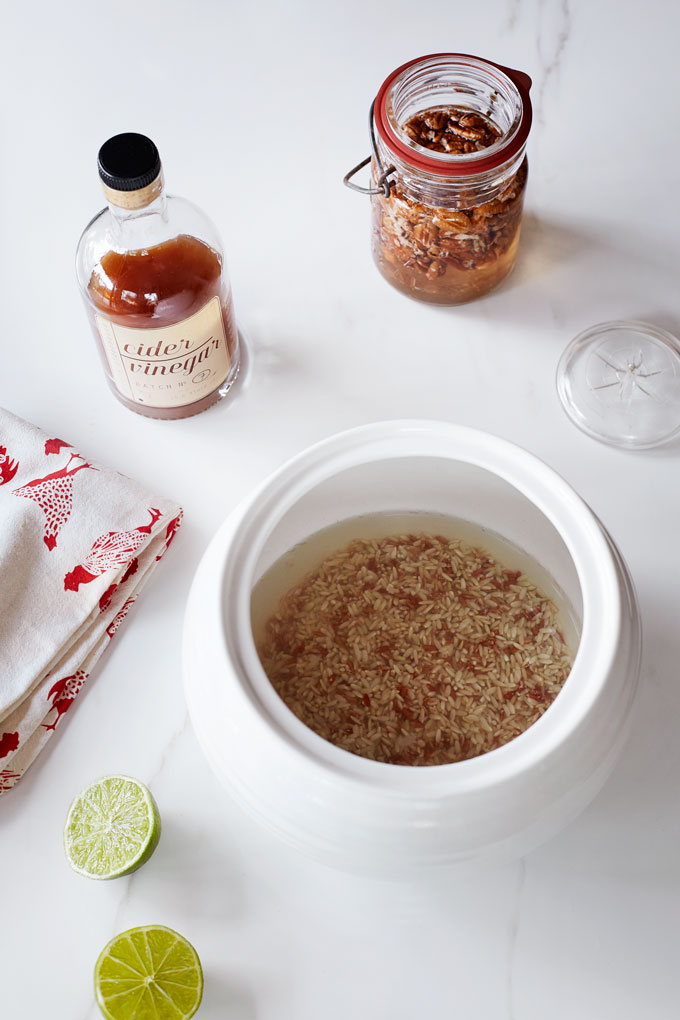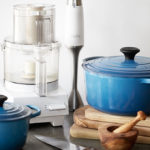Cheater’s Guide To Soaking or Fermenting Grains, Nuts & Legumes
The only tricky piece to soaking or fermenting grains, or nuts and legumes, is remembering to do it in advance of when you plan to eat or cook them. If you can get in a groove with it – you will in time! – it’s just about the easiest step you can take to dramatically improve your long term health. Better yet, to immediately improve your digestion and nutrient absorption.
Just follow these simple steps:
- Use only raw grains, nuts, seeds or legumes.
- Place in a large ceramic or glass bowl (not plastic or metal).
- Cover with plenty of filtered drinking water, 1 to 2 inches above grains.
- Add a splash (about a tablespoon) of acid, vinegar or lemon juice.
- Give it a swirl and cover with a lid or dish towel.
- Place in a dark, warm place (ideally at 70+°F/ 21+°C).
- Soak for a minimum of 7 to 24 hours, up to 5 days.
- For multi-day soaking, drain and replace with fresh water & vinegar every 24 hours.
- Pour out the soaking water and rinse at least once before cooking.
It’s not a problem if your house is cooler than 70°F, but if that’s the case longer soaking times will be more effective. You can also search the house for a warm spot like near a radiator, inside your gas oven or the top of the fridge. In the end, if you can’t find what feels like a warmer spot in the house, don’t worry about it. You’ll still get great results.
For those of you who want to ensure that the enzymes have the right environment to their job, get one of these warming pads and wrap it around the bowl or fermenting jar. They’re only $15 and will double as a great kombucha warmer!
If you’re not ready to cook the grains or legumes when the 24 hour soaking period is up, simply pour out the soaking water and replace with a fresh batch of water and vinegar. You can repeat this for several days if needed, to only reap greater benefits! Alternatively you can pour out the soaking water and place the soaked grains or legumes in the fridge until you’re ready to cook – within 1 to 3 days. But you’d be well advised to take advantage of multi-day soaking. Traditionally in India and in countries throughout Asia, Africa, South America and Europe, lentils and rice or other local grains are soaked for at least two days before being cooked. (Sally Fallon, Nourishing Traditions, pg 452)
MORE ON NUTS & SEEDS
Nuts and seeds are a bit more complicated since the goal isn’t to cook with them. Once wet they’ll be prone to mold if they’re not either dehydrated, or refrigerated and consumed within about 24 hours.
I’ll admit that I don’t often soak or sprout my nuts and seeds. You really need a dehydrator to make the most of it, and due to considerations of space, time and energy, I’ve decided to let that slide. My diet contains a very small fraction of nuts and seeds compared to how much, and how often, grains play a role in my diet. You can drive yourself crazy with too many guidelines, and this feels like a good balance to me!
If you consume a lot of them or it’s just important to you to soak your nuts and seeds, but like me you don’t have access to a dehydrator, you can easily soak small amounts of nuts in a mason jar. Just like in the photo above:
- Fill a jar with nuts, water and a light splash of lemon or lime juice (not vinegar).
- Let them soak sealed for at least 7 hours (ideally at 70+°F/ 21+°C).
- Drain, rinse thoroughly and refrigerate.
- Eat raw, dehydrate, or bake at 200°F for 20-30 minutes.
Aim to eat the plump raw soaked nuts or seeds within a day or two at most. If you don’t mind heating the nuts and loosing the raw qualities, try roasting them! Spread them out on a parchment paper lined baking sheet and bake at 200°F for 20-30 minutes. This produces a wonderfully crispy gesture and delicious heightened flavor. You’ll love this new way of enjoying crispy, healthy, phytic acid free nuts!
Why it’s important to soak or sprout
All grains, nuts and seeds contain a series of anti-nutrients which act as natural pesticides, sprouting inhibitors and other essential factors for the health and life expectancy of the plant. Unfortunately when consumed by humans, unlike the multi-chamber stomachs of ruminants, the acids in our guts are not strong enough to break those chemicals down effectively.
AS A RESULT THE PHYTIC ACID, TANNINS, GLUTEN-RELATED PROTEINS AND ENZYME-INHIBITORS IN UNSOAKED GRAINS WILL:
- bind with essential minerals in the gut, flushing them from your body
- block new mineral absorption
- irritate the gut
- inhibit digestion
- lead to bone loss
- cause allergies
- put stress on the pancreas
Eating lots of baked goods or whole grains and legumes made with unfermented flours can lead to bone loss and serious malabsorption. As they travel through the gut the phytic acids bind with and block the absorption of calcium, magnesium, copper, iron and zinc in particular. This goes for all unsoaked grains, including corn.
Altogether these effects can lead to serious health problems
With the help of vinegar or lemon juice, during the soaking process lactobacilli in acidulated water together with other enzymes neutralize and break down the phytic acid and enzyme inhibitors. The process eliminates anti-nutrient compounds while allowing the plant to sprout. The sprouted seeds released from dormancy become an enzyme rich, live food once again.
Nuetralizing the seed-preserving compounds allows for the body to stay mineralized while being further fortified with essential minerals (meaning that your body cannot produce them) otherwise locked into the grain. Bio-available vitamin content, especially B vitamins, increases, “tannins, complex-sugars, gluten and other difficult-to-digest substances are partially broken down into simpler components that are more readily available for absorption.” (Sally Fallon, Nourishing Traditions, pg 453)
As you can see, this process is non-negotiable if you’d like to improve or maintain good health. The bonus is that your cooking times will be drastically reduced. By about 30% for most grains!
A COUPLE MORE TIPS FOR GOOD HEALTH AND EASE
- For extra pure grains: pour off soaking liquid, add fresh water, stir well and let any bubbles or foam rise, pour water off. Repeat until all the impurities have been released and the water is clear.
- Soaked grains absorb water, decreasing cooking time and grain to water ratios. Add about 1/4 less cooking water than required for the original dry volume of the grain. Once you’ve made soaked grains a few times you’ll get a better sense of water ratios and will develop an intuitive sense of how much less water is required for cooking.
- Store dry grains in a glass container with a tight lid, away from direct sunlight to prevent rancidity of the fragile oils contained in the seeds.
Daily Bread
If you’re thinking to yourself, well that’s all fine and good, but, “what do I do about the copious amounts of bread that I eat throughout each week?”
Don’t you worry, I’ve got a delicious solution for you:
GRINDSTONE BAKERY: SIMPLY THE BEST CELIAC SAFE GLUTEN FREE BREAD
Grindstone bakery, located near Petaluma, California has been my go-to bread source for over seven years now. This is the only bread that I’ve been able to find which is made without any chemicals (store bought gluten free breads are the worst offenders, just take a look at the labels) and made from stoneground whole grains, which are then slow fermented with an authentic starter. The best part is that although this bread is CELIAC SAFE, Mario (owner & baker) also offers naturally low-gluten, heritage grain breads like rye for those who can tolerate gluten. You can read all about his process and see the bakery here >>>
TOOLS TO GET YOU STARTED
-
Soaking Bowl with Lid
-
Warming Pad (only $15.00!) (also great for making kombucha & yogurt)
-
Mason Jar
-
Stainless Steel Mason Jar Ring
-
Vinegar
-
Really Raw Almonds




